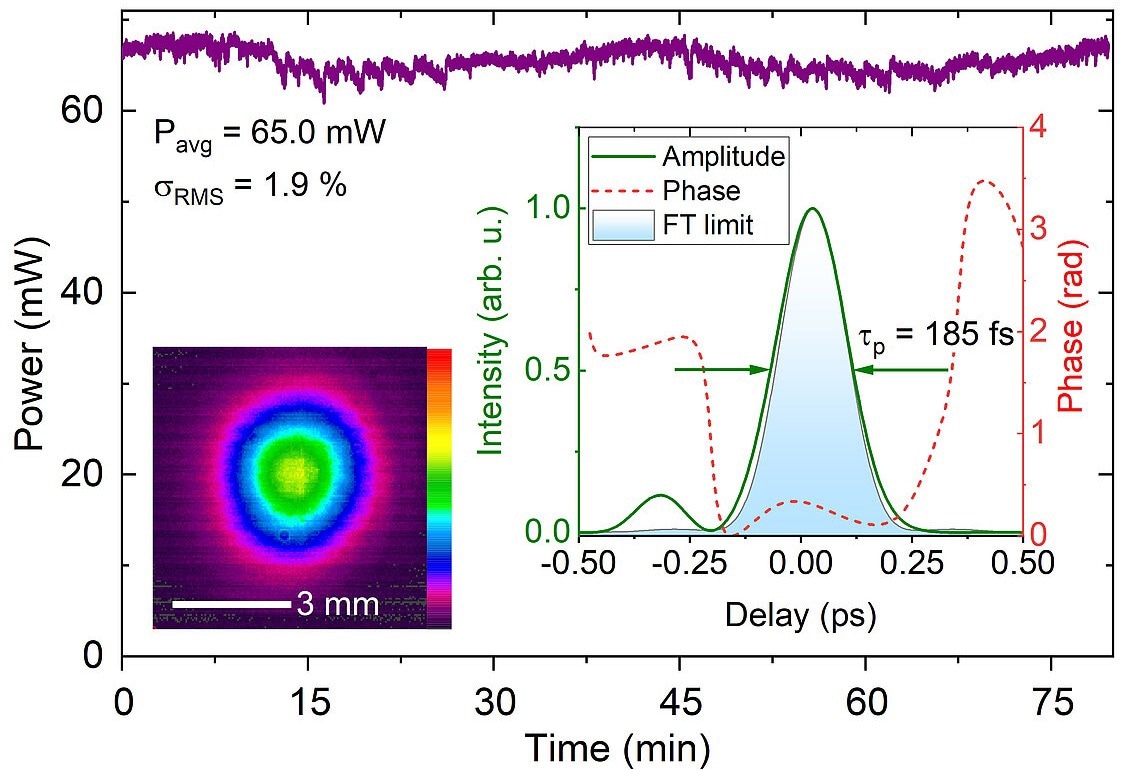Nov 22 2022Reviewed by Danielle Ellis, B.Sc.
A new light source produces ultrashort infrared pulses with previously unachieved peak intensities and stability at wavelengths around 12 µm. The system’s high potential for applications is demonstrated by the first vibrational spectroscopy experiments conducted on water.

Characterization of the OPCPA pulse performance at 11.4 µm. Long-term pulse stability measurement. The average power is 65 mW, the standard deviation ?RMS=1.9%. Left inset: Far-field intensity distribution. Right inset: Retrieved temporal pulse shape of the few-cycle pulse. Image Credit: Max Born Institute
An essential tool for fundamental research, ultrashort light pulses are also used in a wide range of optical technologies. While pulses with wavelengths up to 300 µm are necessary for optical measurement and analysis technology and imaging techniques, the infrared spectral range with wavelengths longer than 1 µm plays a key role in optical communication.
Technically challenging pulses with only a few light wave oscillation cycles (referred to as “few cycle” pulses) are those that are extremely brief. The optical phase and the propagation conditions must be precisely controlled for their generation.
Few-cycle pulses with a high application potential, such as those used in the processing of optical materials, are crucial for studying the non-equilibrium characteristics of condensed matter (solids and liquids) at wavelengths longer than 10 µm. The creation of such pulses is, therefore, a cutting-edge research area.
 Image Credit: Tori Art/Shutterstock.com
Image Credit: Tori Art/Shutterstock.com
Researchers from the Max Born Institute in Berlin describe a new light source that produces ultrashort infrared pulses with record parameters beyond 10 µm wavelength in the journal Optica.
The incredibly small system is based on the idea of optical parametric chirped pulse amplification (OPCPA), in which a weak ultrashort infrared pulse is amplified through interaction with a strong pump pulse of a shorter wavelength in a nonlinear crystal.
A three-stage parametric amplifier in the novel light source is driven with a pump energy of 6 mJ by pump pulses with a duration of about 3 ps and a 2 µm wavelength.
Within roughly five optical cycles of the light wave, the amplified pulses at a wavelength of about 12 µm have an energy of 65 µJ and a duration of 185 fs, which corresponds to a peak power of about 0.4 gigawatts (1 GW=109 W).
The pulses in the 1 kHz train have excellent optical beam quality and are very stable. The system's output power and repetition rate are scalable.
Experiments with liquid water showed the potential of this unusual source. For the first time, water molecules’ hindered rotations, or “librations,” were excited to the point where their optical absorption significantly decreased. An estimated lifetime of the librational excitation of 20 to 30 fs is obtained from the analysis of this absorption saturation.
Journal Reference:
Fuertjes, P., et al. (2022) Few-cycle 65-µJ pulses at 11.4 µm for ultrafast nonlinear longwave-infrared spectroscopy. Optica. doi:10.1364/OPTICA.472650.
Source: https://mbi-berlin.de/homepage